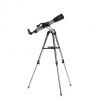Meade NG70-SM Instruction Manual - Page 14
Taking Care Of Your Telescope - instruments
 |
View all Meade NG70-SM manuals
Add to My Manuals
Save this manual to your list of manuals |
Page 14 highlights
USE THE SPECIFICATIONS TO CALCULATE THE MAGNIFICATION OF 12 YOUR EYEPIECE The power of a telescope is how much it magnifies objects. Your 25mm eyepiece magnifies an object 28 times. Your 9mm eyepiece magnifies objects 78 times. But if you obtain other eyepieces, you can calculate how much magnification they have with your telescope. Just divide the focal length of the telescope by the focal length of the eyepiece. Focal Length of the Telescope ÷ Focal Length of the Eyepiece = Magnification Look at the specifications. You will see that the focal length of your scope is 700mm. Let's say that you have obtained a 13mm eyepiece. You can tell that what the focal length of your eyepiece is as it is always printed on the side of an eyepiece. Divide: 700 ÷ 13, which equals 53.8. Round this off to the nearest whole number and your new eyepiece magnifies objects 54 times. Its worth repeating: Keep in mind that a bright, clear, but smaller image is more interesting than a larger, dimmer, fuzzy one. Using too high a power eyepiece is one of the most common mistakes made by new astronomers. So don't think that higher magnification is necessarily better-quite often the best view is with lower magnification value! TAKING CARE OF YOUR TELESCOPE Your telescope is a precision optical instrument designed for a lifetime of rewarding viewing. It will rarely, if ever, require factory servicing or maintenance. Follow these guidelines to keep your telescope in the best condition: • Avoid cleaning the telescope's lenses. A little dust on the front surface of the telescope's correcting lens will not cause loss of image quality. JOIN AN ASTRONOMY CLUB, ATTEND A STAR PARTY One of the best ways to increase your knowledge of astronomy is to join an astronomy club. Check your local newspaper, school, library, or telescope dealer/ store to find out if there's a club in your area. Many groups also hold regularly scheduled Star Parties at which you can check out and observe with many different telescopes and other pieces of astronomical equipment. Magazines such as Sky and Telescope and Astronomy print schedules for many popular Star Parties around the United States and Canada. Looking at or near the Sun will cause irreversible damage to your eye. Do not point this telescope at or near the Sun. Do not look through the telescope as it is moving.















